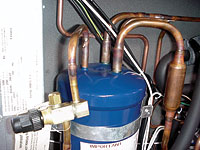
Gravity or harvest-assist push-pins help the ice sheet fall off the evaporator and into the ice storage bin. Once the hot gas gives up its heat to the ice sheet, it may change to a liquid if enough heat is lost to the ice. A suction line accumulator is usually placed in the suction line before the compressor to protect the compressor from slugging and/or flooding. (See Figure 1.)

During the harvest mode, the receiver gets a mixture of hot gas from the compressor's discharge line and liquid from the condenser. A head pressure control valve located between the condenser and receiver (Figure 2) mixes the hot gas and condenser liquid, ensuring that the vapor from the top of the condenser is warm enough for defrost purposes.
Gas from the top of the receiver is not as hot as it is in a standard hot gas defrost system where hot gas comes directly from the compressor discharge line. However, it doesn't have to be that hot for ice harvesting purposes on an ice machine.

In this case, three lines protrude from the receiver on the inside ice-making unit. (See Figure 4). The defrost solenoid opens the defrost gas line from the top of the receiver; the high-side system pressure drop then allows the head pressure control valve to bypass more hot gas from the compressor to the receiver.
This ensures that the gas from the top of the receiver has enough heat intensity to defrost the ice from the evaporator.

Operation
Note that two pressures operate the head pressure control valve. The pressure from a charged bonnet, which is exposed to the outside ambient temperature, pushes the piston down. Condenser liquid (condenser outlet) pressure pushes the piston up.When the temperature of the condenser (outside ambient) is above a set temperature, usually 70 degrees F, hot gas from the compressor is directed through the condenser and into the receiver.
When the outside ambient temperature drops below a set point, again usually 70 degrees, the pressure in the charged bellows of the head pressure control valve become greater than the pressure at the condenser's outlet.
This change in pressure allows the head pressure control valve to partially restrict the flow of liquid leaving the condenser. At the same time, it allows more hot gas from the compressor to bypass the condenser and flow directly to the receiver, where it mixes with liquid refrigerant from the condenser.
Charges in the bonnet of the valve can be customized to meet specific needs and bypass pressures.
John Tomczyk is a professor of HVACR at Ferris State University, Big Rapids, Mich., and the author of Troubleshooting and Servicing Modern Air Conditioning & Refrigeration Systems, published by ESCO Press. To order, call 800-726-9696. Tomczyk can be reached by e-mail at tomczykj@tucker-usa.com.
Publication date: 11/01/2004

Report Abusive Comment